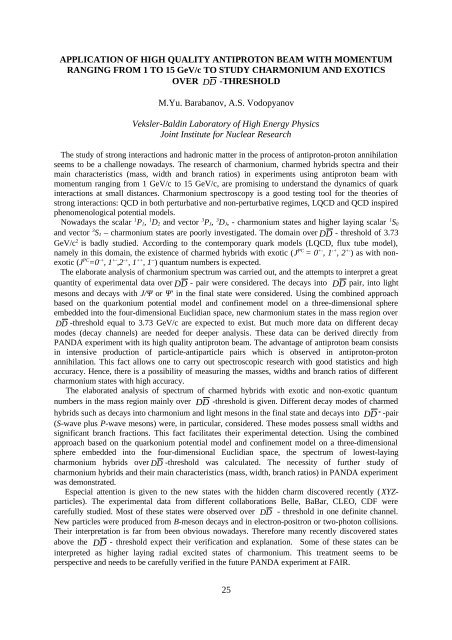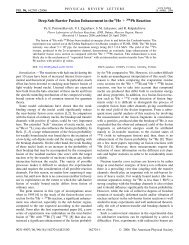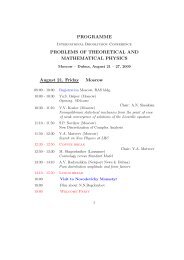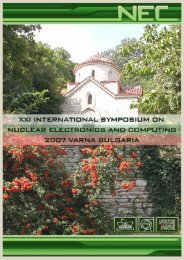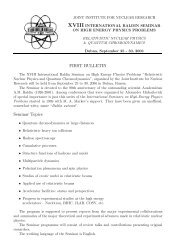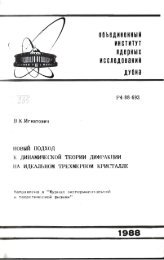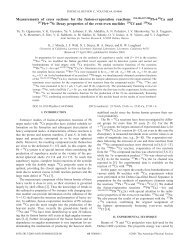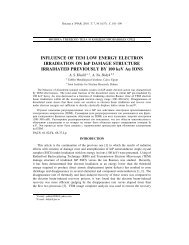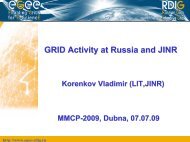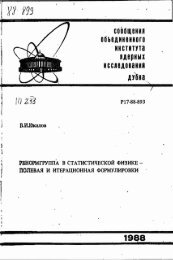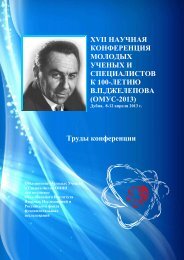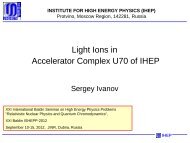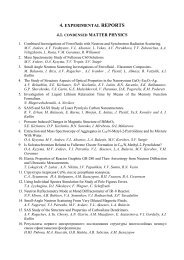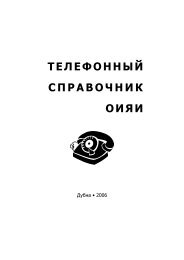Joint Institute for Nuclear Research Relativistic ... - Index of - JINR
Joint Institute for Nuclear Research Relativistic ... - Index of - JINR
Joint Institute for Nuclear Research Relativistic ... - Index of - JINR
Create successful ePaper yourself
Turn your PDF publications into a flip-book with our unique Google optimized e-Paper software.
APPLICATION OF HIGH QUALITY ANTIPROTON BEAM WITH MOMENTUM<br />
RANGING FROM 1 TO 15 GeV/c TO STUDY CHARMONIUM AND EXOTICS<br />
OVER DD<br />
-THRESHOLD<br />
M.Yu. Barabanov, A.S. Vodopyanov<br />
Veksler-Baldin Laboratory <strong>of</strong> High Energy Physics<br />
<strong>Joint</strong> <strong>Institute</strong> <strong>for</strong> <strong>Nuclear</strong> <strong>Research</strong><br />
The study <strong>of</strong> strong interactions and hadronic matter in the process <strong>of</strong> antiproton-proton annihilation<br />
seems to be a challenge nowadays. The research <strong>of</strong> charmonium, charmed hybrids spectra and their<br />
main characteristics (mass, width and branch ratios) in experiments using antiproton beam with<br />
momentum ranging from 1 GeV/c to 15 GeV/c, are promising to understand the dynamics <strong>of</strong> quark<br />
interactions at small distances. Charmonium spectroscopy is a good testing tool <strong>for</strong> the theories <strong>of</strong><br />
strong interactions: QCD in both perturbative and non-perturbative regimes, LQCD and QCD inspired<br />
phenomenological potential models.<br />
Nowadays the scalar 1 P 1 , 1 D 2 and vector 3 P J , 3 D J , - charmonium states and higher laying scalar 1 S 0<br />
and vector 3 S 1 – charmonium states are poorly investigated. The domain over DD<br />
- threshold <strong>of</strong> 3.73<br />
GeV/c 2 is badly studied. According to the contemporary quark models (LQCD, flux tube model),<br />
namely in this domain, the existence <strong>of</strong> charmed hybrids with exotic (J PC = 0 +- , 1 -+ , 2 +- ) as with nonexotic<br />
(J PC =0 -+ , 1 +- ,2 -+ , 1 ++ , 1 -- ) quantum numbers is expected.<br />
The elaborate analysis <strong>of</strong> charmonium spectrum was carried out, and the attempts to interpret a great<br />
quantity <strong>of</strong> experimental data over DD<br />
- pair were considered. The decays into DD<br />
pair, into light<br />
mesons and decays with J/Ψ or Ψ' in the final state were considered. Using the combined approach<br />
based on the quarkonium potential model and confinement model on a three-dimensional sphere<br />
embedded into the four-dimensional Euclidian space, new charmonium states in the mass region over<br />
DD<br />
-threshold equal to 3.73 GeV/c are expected to exist. But much more data on different decay<br />
modes (decay channels) are needed <strong>for</strong> deeper analysis. These data can be derived directly from<br />
PANDA experiment with its high quality antiproton beam. The advantage <strong>of</strong> antiproton beam consists<br />
in intensive production <strong>of</strong> particle-antiparticle pairs which is observed in antiproton-proton<br />
annihilation. This fact allows one to carry out spectroscopic research with good statistics and high<br />
accuracy. Hence, there is a possibility <strong>of</strong> measuring the masses, widths and branch ratios <strong>of</strong> different<br />
charmonium states with high accuracy.<br />
The elaborated analysis <strong>of</strong> spectrum <strong>of</strong> charmed hybrids with exotic and non-exotic quantum<br />
numbers in the mass region mainly over DD<br />
-threshold is given. Different decay modes <strong>of</strong> charmed<br />
hybrids such as decays into charmonium and light mesons in the final state and decays into DD<br />
* -pair<br />
(S-wave plus P-wave mesons) were, in particular, considered. These modes possess small widths and<br />
significant branch fractions. This fact facilitates their experimental detection. Using the combined<br />
approach based on the quarkonium potential model and confinement model on a three-dimensional<br />
sphere embedded into the four-dimensional Euclidian space, the spectrum <strong>of</strong> lowest-laying<br />
charmonium hybrids over DD<br />
-threshold was calculated. The necessity <strong>of</strong> further study <strong>of</strong><br />
charmonium hybrids and their main characteristics (mass, width, branch ratios) in PANDA experiment<br />
was demonstrated.<br />
Especial attention is given to the new states with the hidden charm discovered recently ( XYZparticles).<br />
The experimental data from different collaborations Belle, BaBar, CLEO, CDF were<br />
carefully studied. Most <strong>of</strong> these states were observed over D D - threshold in one definite channel.<br />
New particles were produced from B-meson decays and in electron-positron or two-photon collisions.<br />
Their interpretation is far from been obvious nowadays. There<strong>for</strong>e many recently discovered states<br />
above the DD<br />
- threshold expect their verification and explanation. Some <strong>of</strong> these states can be<br />
interpreted as higher laying radial excited states <strong>of</strong> charmonium. This treatment seems to be<br />
perspective and needs to be carefully verified in the future PANDA experiment at FAIR.<br />
25


